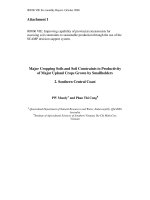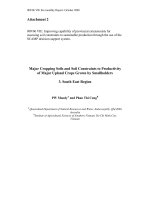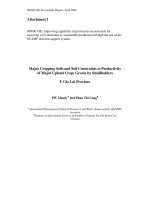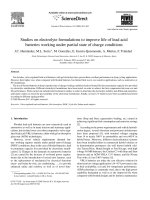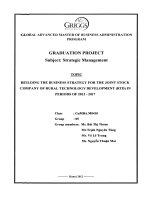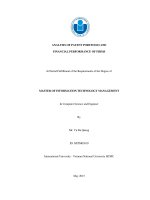Job productivity of assistant technology managers working under centrally sponsored scheme agricultural technology management Agency in Assam, India
Bạn đang xem bản rút gọn của tài liệu. Xem và tải ngay bản đầy đủ của tài liệu tại đây (200.82 KB, 5 trang )
Int.J.Curr.Microbiol.App.Sci (2017) 6(6): 2400-2404
International Journal of Current Microbiology and Applied Sciences
ISSN: 2319-7706 Volume 6 Number 6 (2017) pp. 2400-2404
Journal homepage:
Original Research Article
/>
Job Productivity of Assistant Technology Managers Working under Centrally
Sponsored Scheme Agricultural Technology Management Agency in Assam, India
S.K. Reddy* and P. Mishra
Department of Extension Education, Assam Agricultural University,
Jorhat-785013, Assam, India
*Corresponding author
ABSTRACT
Keywords
Agricultural
Technology
Management
Agency,
Job
productivity.
Article Info
Accepted:
26 April 2017
Available Online:
10 May 2017
The main purpose of this study was to investigate the job productivity of the Assistant
Technology Managers. A survey of 60 Assistant Technology Managers was conducted
in Assam Agricultural University, Jorhat. Job productivity was measured with a selfevaluation mail questionnaire. The study found that the majority of the ATMs
(71.66%) belonged to medium level of job productivity, followed by 20.00% and
8.33% belonging to low and high level of job productivity, respectively. The
independent variables were Age, Service Experience, Perceived organizational
support, Job involvement and Achievement motivation had positive and significant
relationship with the job productivity of the ATMs’. The independent variables like
Sex, Marital status, Educational background, job satisfaction Perceived work
environment, Attitude towards extension work exhibited positive but non-significant
relation with the job productivity. Administration should conduct a periodic needs
assessment to determine the level of job productivity of ATMs’ and identify methods
for increasing job productivity based on these findings.
Introduction
The share of agricultural sector is gradually
reducing towards total GDP in India. The
main reason for this is unawareness of the
rural farm families regarding the new
technologies. The Assistant Technology
managers have a big role to play in transfer of
technologies at the block level. So, the
ATM’s need to be productive in their work.
Keeping this in view, present study was
undertaken in Assam at Assam Agricultural
University to measure the job productivity of
Assistant Technology Managers.
his or her talents and skills to perform their
work, using available materials, within a
specific period of time (Ruch, 1994). The
Objectives of the study is to find out the job
productivity of Assistant Technology
Managers (ATM’s) and to explore the
relationship between job productivity and
selected socio-personal and psychological
characteristics of Assistant Technology
Managers (ATM’s).
At the individual level, productivity refers to
the effectiveness with which a worker applies
Keeping the above objectives in mind, present
study was conducted at Assam Agricultural
Materials and Methods
2400
Int.J.Curr.Microbiol.App.Sci (2017) 6(6): 2400-2404
University, Jorhat during 2014-2015. A
judgmental or purposive sampling procedure
was selected for the study to select the
respondents. All the 14 districts were targeted
to select the respondents which were having
the Centrally Sponsored Scheme (CSS)
ATMA. The ATMs, who are working under
CSS-ATMA and having e-mail I.D.s, were
selected for the study and the pre-tested
questionnaires sent through e-mails. These 14
districts were having 114 blocks, but because
of the un-availability of the e-mail I.D.s, only
95 block were targeted to send the
questionnaires. These 95 blocks were having
66 ATMs. From those, 60 responses which
were filled-up completely, taken for the study.
The data were obtained from 60 ATMs i.e.
90.00 percent of the respondents. The job
productivity is selected as dependent variable.
Eight independent variables were selected.
The statistical methods such as mean,
standard deviation, coefficient of correlation
and ‘t’ tests were used for analysis of data.
of the respondents perceived that they have
less favourable work environment. Majority
(61.66%) of the respondents had medium
level of job involvement followed by 16.66
percent of them had low job involvement and
another 21.66 percent of the respondents had
high level of job involvement. Majority
(63.33%) of the respondents had medium
level of achievement motivation, while the
same proportion (18.33%) of the respondents
had low and high level of achievement
motivation respectively. 56.66 per cent of the
respondents had less favorable attitude
towards extension work. The remaining 43.33
per cent of the respondents had more
favorable attitude towards the extension work.
Majority (51.66%) of the respondents had
medium level of job satisfaction followed by
31.66 percent of them had low job satisfaction
and another 16.66 percent of the respondents
had high level of job satisfaction.
Job productivity of the assistant technology
managers
Results and Discussions
Table 1 indicates that, majority (61.66%) of
the respondents belonged to medium age
group of 27-35 years followed by 20.00 per
cent of the respondents belonged to lower age
group of below 27and 18.33 per cent of the
respondents belonged to high age group of
above 35 years. Majority (75.00%) of the
respondents had medium level of service
experience of 2 – 7 years. After that, 15.00
per cent of the respondents had higher service
experience of 8 – 10 years and 10.00 per cent
of the respondents had less service experience
of six months to one year. Majority (63.33%)
of the respondents perceived that they have
medium level of organizational support
followed by 18.33 per cent of the respondents
were in the low level category. Another 18.33
per cent of the respondents were in the high
category. Majority of the respondents
(55.00%) perceived that they have more
favourable work environment, the rest (45.00)
Table 2 shows that majority (71.66%) of the
respondents belonged to medium level of job
productivity followed by 20.00 percent of the
respondents belonged to low level of job
productivity and very low per cent (8.33%) of
the respondents belonged to high level of job
productivity.
Hegde and Channegowda (1989) found that
majority of the Agricultural Assistants had
medium job performance followed by some
of them had low job performance and very
low per cent of the respondents had high job
performance. Singh et al., (1971) rated the job
performance of majority of the Block
Development Officers as average to good and
found that the job performance of agricultural
graduate Block Development Officers were
significantly superior to that of non
agricultural graduate Block Development
Officers.
2401
Int.J.Curr.Microbiol.App.Sci (2017) 6(6): 2400-2404
Job productivity of
individual job items
the
ATMs
on
The job productivity criterion which is
selected here is based on their activities which
are assigned to them. The mean scores on
each of the job productivity items were
calculated separately. These are presented in
the below table. A perusal of table 3 reveals
that the level of performance of the
respondents on different job activities had
wide variation. The highest mean scores were
observed
in
case
of
conducting
demonstrations
(2.78),
followed
by
organizing
training
programs
(2.71),
organizing farm schools (2.51), Providing
necessary inputs to Common Service Centers
(CSCs) and Kissan Call Centers (KCCs)
(2.18), organizing field days (2.11), Providing
requisite technical and knowledge support to
farm
school,
farmer
friend,
FIGs/CIGs/FSGs/FPOs and farmer in general
(2.03), Organizing and monitoring of
Commodity Interest Groups (CIGs) and
Farmer Interest Groups (FIGs) (1.86),
Monitoring and evaluation of extension
activities (1.76), organizing exposure visits
(1.50). The mean score of the activity
conducting demonstrations was the highest.
This means, the ATM’s were also good at
conducting demonstrations. The mean scores
for organizing exposure visits and monitoring
and evaluation of extension activities were the
lowest. This means, the ATM’s performance
is very low in organizing exposure visits and
Monitoring and evaluation of extension
activities.
Table.1 Frequency distribution of respondents according to their
socio-personal and psychological attributes (N=60)
S.No.
Independent Variables
1.
Age
Frequency
Percentage
Below 27 years
27-35 years
Above 35 years
Service Experience
<2 years
2-7 years
>7 years
Perceived
organizational Low (<13)
support
Medium (13-25)
High (>25)
Perceived work
Less favorable (Up to 11)
environment
More favorable (Above 11)
12
37
11
6
45
9
11
38
11
27
33
20.00
61.66
18.33
10.00
75.00
15.00
18.33
63.33
18.33
45.00
55.00
5.
Job involvement
6.
Achievement motivation
7.
Attitude towards extension
work
Low (<20)
Medium (20-28)
High (>28)
Low (<16)
Medium (16-24)
High (>24)
Less favorable (Up to 19)
More favorable (Above 19)
10
37
13
11
38
11
34
26
16.66
61.66
21.66
18.33
63.33
18.33
56.66
43.33
8.
Job satisfaction
Low (<12)
Medium (12-32)
High (Above 32)
19
31
10
31.66
51.66
16.66
2.
3.
4.
Categories
2402
Int.J.Curr.Microbiol.App.Sci (2017) 6(6): 2400-2404
Table.2 Job productivity of the Assistant Technology Managers: N=60
Dependent variable
Category
Low (10-13)
Medium (14-25)
High (26-27)
Job Productivity
Frequency
12
43
5
Percentage
20.00
71.66
8.33
Table.3 Mean scores of ATMs on individual items of job productivity N=60
Sl. No.
1.
2.
3.
4.
5.
6.
7.
8.
9.
Criteria
Mean
Organizing and monitoring of Commodity Interest
Groups (CIGs) and Farmer Interest Groups (FIGs)
Providing necessary inputs to Common Service
Centers (CSCs) and Kissan Call Centers (KCCs)
Organizing farm schools
Organizing training programs
Organizing exposure visits
Conducting demonstrations
Organizing field days
Providing requisite technical and knowledge
support to farm school, farmer friend,
FIGs/CIGs/FSGs/FPOs and farmer in general
Monitoring and evaluation of extension activities
S.D.
C.V.
1.86
Score
Range
0-4
1.26
67.74
2.18
0-4
1.24
56.88
2.51
2.71
1.50
2.78
2.11
2.03
1-4
0-4
0-4
0-4
0-4
0-4
1.28
1.59
0.88
1.29
1.36
1.19
50.99
58.67
58.66
46.40
64.45
58.62
1.76
0-4
1.76
100.00
Table.4 Correlation coefficient between Assistant Technology Managers’ Job productivity and
independent variables: N=60
S.No.
Independent variables
Correlation coefficient (‘r’)
1.
Age
0.484**
2.
Service experience
0.705**
3.
Perceived organizational support
0.363**
4.
Perceived work environment
0.055
5.
Job involvement
0.384**
6.
Achievement motivation
0.629**
7.
Attitude towards extension work
0.038
8.
Job satisfaction
0.119
** Significant at 0.01 level probability
* significant at 0.05 level probability.
As the ATM’s performance in conducting
demonstrations is high which increases their
job productivity, but probably they have low
capability to deal with monitoring and
2403
Int.J.Curr.Microbiol.App.Sci (2017) 6(6): 2400-2404
evaluation of extension activities which
relates to their problems and organizing
exposure visits. The ATMs’ performance is
good at conducting training programs but
unable to monitor and evaluate extension
activities and organize the exposure visits.
The reasons for the low performance in these
two activities may be because of
communication gap between ATMs and their
superiors and the irregular release of funds
from government.
employees.
In conclusion, the study revealed that, there is
a positive and significant correlation between
perceived organizational support, job
involvement and achievement motivation
with the job productivity. This implies that,
manipulation of these variables can increase
the job productivity of the Assistant
Technology Managers (ATM) working under
Centrally Sponsored Scheme Agricultural
Technology Management Agency in Assam.
Relationship
between
independent
variables and Job productivity
References
Correlation between independent variables
and Job productivity
Brayfield, A.H. and Crockett, W.H. (1965).
Employee’s Attitude and Employee’s
Performance, Psychological Bulletin: 52:
396-424.
Halakatti, S.V.; Sundaraswamy, B. and
Nagnur, S. (1977). Job performance of
Agril. Assistants AgrilExtn. Review, pp.
28-30.
Hegde, V.G. and Channegowda, M.B. (1989).
Influence of personal characteristics of
Agril.Assistants on their job performance.
Indian J. Extn. Edn.XXV (3&4): 100-102.
Ruch, W.A. (1994). Measuring and managing
individual productivity. In : Harris, D.H.
(Ed.),
Organizational
Linkages:
Understanding the productivity paradox.
National Academy Press, Washington,
DC.
Singh, B.P. and Shukla, A.N. (1971). Role
performance of Block Development and
Panchayat Officers in Agricultural
Development in Punjab. Indian J. Extn.
Edn. XVI (2).
Vroom, V. (1964). Work and Motivation,
John Willy : New York.
Correlation between Assistant Technology
Managers’ job productivity and independent
variables was given in table 4. All the
independent variables were measured by
correlation coefficient analysis. Out of eight
variables age, service experience, perceived
organizational support, job involvement and
achievement motivation were having positive
and significant correlation, but perceived
work environment, attitude towards extension
work and job satisfaction were having
positive but non-significant correlation.
Halakatti et al., (1977) found that job attitude,
mass media exposure, job perception,
achievement
motivation,
organizational
climate, organizational commitment, job
involvement, job satisfaction, job stress and
organizational stress of Agricultural Assistant
were significantly associated with their job
performance. Brayfield (1965) and Vroom
(1964) found weak relationship between job
satisfaction and job performance of the
How to cite this article:
Reddy, S.K. and Mishra, P. 2017. Job Productivity of Assistant Technology Managers Working
under Centrally Sponsored Scheme Agricultural Technology Management Agency in Assam,
India. Int.J.Curr.Microbiol.App.Sci. 6(6): 2400-2404.
doi: />
2404


